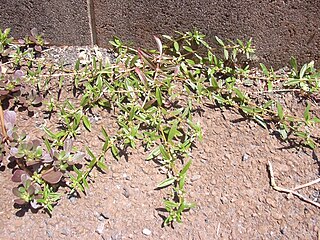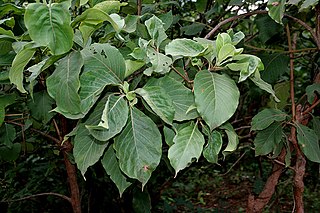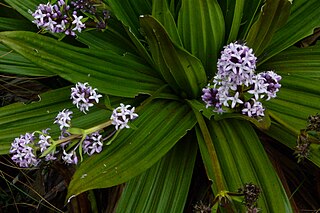Related Research Articles

Uncaria is a genus of flowering plants in the family Rubiaceae. It has about 40 species. Their distribution is pantropical, with most species native to tropical Asia, three from Africa and the Mediterranean and two from the neotropics. They are known colloquially as gambier, cat's claw or uña de gato. The latter two names are shared with several other plants. The type species for the genus is Uncaria guianensis.

Diederich Franz Leonhard von Schlechtendal was a German botanist. The standard author abbreviation Schltdl. is used to indicate this person as the author when citing a botanical name.

Houstonia (bluet) is a genus of plants in the family Rubiaceae. Many species were formerly classified, along with other genera since segregated elsewhere, in a more inclusive genus Hedyotis.

Oldenlandia is a genus of flowering plants in the family Rubiaceae. It is pantropical in distribution and has about 240 species. The type species for the genus is Oldenlandia corymbosa.

Exostema is a genus of flowering plants in the family Rubiaceae. It consists of trees and shrubs, endemic to the neotropics, with most of the species occurring in the West Indies.

Guettarda is a plant genus in the family Rubiaceae. Most of these plants are known by the common name Velvetseed. Estimates of the number of species range from about 50 to 162. Most of the species are neotropical. Twenty are found in New Caledonia and one reaches Australia. A few others are found on islands and in coastal areas of the Indian and Pacific Oceans.
Machaonia is a genus of flowering plants in the family Rubiaceae. It has about 32 species. All are indigenous to the neotropics. None has a unique common name. Some species have been called "alfilerillo", a Spanish name for the common and well-known genus Erodium. The type species for Machaonia is Machaonia acuminata.

Rondeletia is a genus of flowering plants in the family Rubiaceae. It is endemic to the Neotropics. There are around 160 species.

Hedyotis (starviolet) is a genus of flowering plants in the family Rubiaceae. Many species of this genus such as Hedyotis biflora, H. corymbosa and H. diffusa are well known medicinal plants. Hedyotis is native to tropical and subtropical Asia and to islands of the northwest Pacific. It comprises about 115 species. The type species for the genus is Hedyotis fruticosa.

Kadua is a genus of flowering plants in the family Rubiaceae. It comprises 29 species, all restricted to Polynesia. Twenty-two of these are endemic to the Hawaiian Islands. Some of the species are common at high elevation. Others are single-island endemics or very rare, and a few are probably extinct. Kadua affinis is widely distributed in Hawaii and is polymorphic. The type species for the genus is Kadua acuminata.
Chione is a monotypic genus of flowering plants in the family Rubiaceae containing the single species Chione venosa. It is native to the neotropics, occurring in most of Mexico, and throughout Central America, the Caribbean, Colombia, Ecuador, and Peru. It is typically a tree growing 10 to 20 meters tall. In harsh habitats, it may be dwarfed and shrubby. It has no known economic use.

Hymenodictyon is a genus of flowering plants in the family Rubiaceae. It has about 30 species. All are native to the Old World. The wood of Hymenodictyon orixense is soft and has limited use, mostly for boxes. The type species for Hymenodictyon is Hymenodictyon orixense.

Adina is a genus of 11 species of flowering plants in the family Rubiaceae. They are shrubs or small trees, native to East Asia and Southeast Asia.

Arcytophyllum is a genus of flowering plants in the family Rubiaceae. The genus contains 18 species, distributed from New Mexico to Bolivia.

Deppea is a genus of flowering plants in the family Rubiaceae. The genus is found in Mexico, Central America and from Brazil to northeastern Argentina.

Hedyotis verticillaris is a plant belonging to the family Rubiaceae that is endemic to the higher altitude grasslands of the Nilgiris in southern India. Unlike many others members of the genus the stems of this species are underground and the leaves appear close to the ground forming rosettes and usually hold some water at the centre of the whorl of leaves. The flowers are produced on a stalk.
Cordylostigma is a genus in the Rubiaceae. The name was coined in 2010 to contain 9 species formerly belonging to the related genus Kohautia. The nine species are native to tropical and southern Africa from Guinea to Somalia to South Africa, as well as Madagascar, Comoros, and Réunion.

Spermacoceae is a tribe of flowering plants in the family Rubiaceae and contains about 1346 species in 57 genera. Its representatives are found in the tropics and subtropics.
Involucrella is a genus of flowering plants in the family Rubiaceae. The genus is found from Assam to Hainan and Peninsular Malaysia and the Philippines.
Birgitta Bremer, Swedish botanist and academic, is professor at Stockholm University, and director of the Bergius Botanic Garden.
References
- ↑ David J. Mabberley. 2008. Mabberley's Plant-Book third edition (2008). Cambridge University Press: UK. ISBN 978-0-521-82071-4
- 1 2 Inge Groeninckx, Steven Dessein, Helga Ochoterena, Claes Persson, Timothy J. Motley, Jesper Kårehed, Birgitta Bremer, Suzy Huysmans, and Erik Smets. 2009. "Phylogeny of the herbaceous tribe Spermacoceae (Rubiaceae) based on plastid DNA data". Annals of the Missouri Botanical Garden96(1):109-132.
- ↑ Kohautia In: Index Nominum Genericorum. In: Regnum Vegetabile (see External links below).
- ↑ Adelbert von Chamisso and Diederich von Schlechtendal. 1829. Linnaea4:157. (see External links below)
- ↑ Umberto Quattrocchi. 2000. CRC World Dictionary of Plant Names volume II. CRC Press: Boca Raton; New York; Washington,DC;, USA. London, UK. ISBN 978-0-8493-2676-9.
- ↑ Jesper Kårehed, Inge Groeninckx, Steven Dessein, Timothy J. Motley, and Birgitta Bremer. 2008. "The phylogenetic utility of chloroplast and nuclear DNA markers and the phylogeny of the Rubiaceae tribe Spermacoceae". Molecular Phylogenetics and Evolution49(3):843-866. doi : 10.1016/j.ympev.2008.09.025